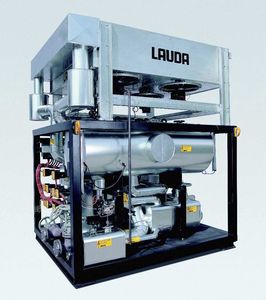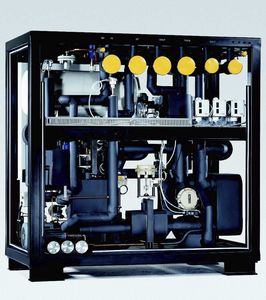
- Robotics - Automation - Industrial IT
- Automation
- Temperature control system
- LAUDA DR. R. WOBSER GMBH & CO. KG
Temperature control system
Add to favorites
Compare this product
Description
Using molten salt as a heat carrier has real advantages, especially in the temperature range from 120 °C to 550 °C, compared to thermal oils, which are limited to an operating temperature of approximately 400 °C. Salt mixtures are liquid under such operating conditions and have advantages such as low viscosity, high heat capacity and pressureless operation. Self-draining systems also ensure high levels of operational safety. Cooling modules that cool down salt mixtures close to their setting point, accurately to within one degree, can also be fitted as needed. This makes it possible to realize a temperature control system with a unique working temperature range. This is not possible using other heat carriers. Application areas include, for example, aluminum dioxide or melamine production as well as lye evaporation and various high-temperature reactions.
Functional diagram of a temperature control system using liquid salt as a heat carrier
Temperature control systems that use liquid salt as a heat carrier have a heated floor tank equipped with a submersible pump. When the pump is switched off, the salt mixture is fed back into the tank to prevent salt from solidifying in the plant. The salt pump conveys the heat carrier to the heater, which can be an electric heater or a fuel-fired boiler, where the salt mixture is heated to the required temperature. An installed air or water cooler can be used to cool down the heat carrier to any temperature above its solidification point.
Catalogs
No catalogs are available for this product.
See all of LAUDA DR. R. WOBSER GMBH & CO. KG‘s catalogsExhibitions
Meet this supplier at the following exhibition(s):

Hyvolution 2025
28-30 Jan 2025 paris (France) Stand 4M38
Other LAUDA DR. R. WOBSER GMBH & CO. KG products
Industrial Heating and cooling systems
Related Searches
- Digital temperature control
- PID temperature control
- LAUDA temperature regulator
- Digital thermal regulator
- Temperature control system
- Technology temperature regulator
- PID thermal regulator
- Cooling thermal regulator
- Heating thermal regulator
- Modular temperature control
- LAUDA process temperature regulator
- Thermoelectric temperature regulator
- Industrial thermal regulator
- Modular temperature regulator
- Temperature regulator without display
- Ambient temperature temperature regulator
- Ethernet temperature regulator
*Prices are pre-tax. They exclude delivery charges and customs duties and do not include additional charges for installation or activation options. Prices are indicative only and may vary by country, with changes to the cost of raw materials and exchange rates.








